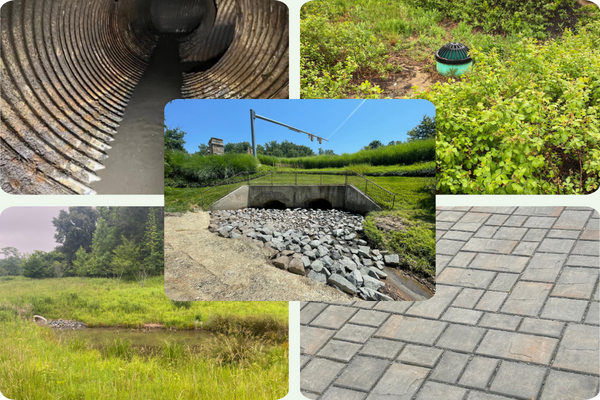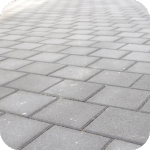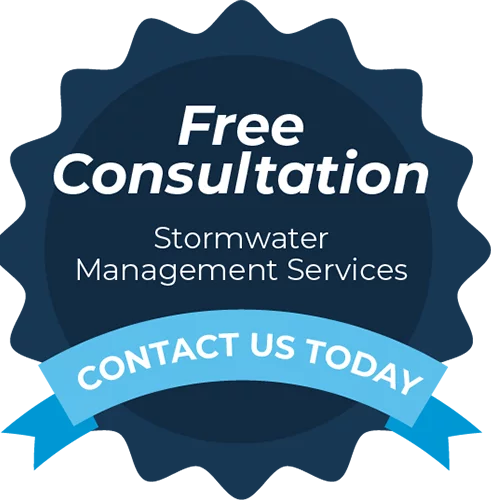As stormwater management continues to evolve, it’s important to understand the terms and concepts that drive the industry. Whether you’re managing a property, working on a construction project, or ensuring compliance with environmental regulations, knowing the right stormwater terminology is key. Below, we break down essential terms to help you navigate stormwater management more effectively.

Key Stormwater Terms
Best Management Practices (BMPs)
Best Management Practices, or BMPs, refer to techniques, measures, or structural controls that are implemented to manage the quantity and improve the quality of stormwater runoff. These practices aim to reduce erosion, prevent pollutants from reaching water bodies, and help comply with local and federal stormwater regulations.
Stormwater Runoff
Stormwater runoff refers to rainwater or melted snow that flows over land surfaces and impervious areas like roads, parking lots, and roofs. This water often picks up pollutants such as oil, chemicals, and debris, which can contaminate rivers, lakes, and oceans if left unmanaged.
Detention Basin
A detention basin is a stormwater management structure designed to temporarily store runoff. By holding water after heavy rain, it helps control the release of stormwater at a slower, controlled rate, reducing the risk of flooding and downstream erosion.
Retention Pond
A retention pond is similar to a detention basin but differs in one key aspect: it is designed to hold a permanent pool of water. The pond stores excess stormwater during rainfall and allows pollutants to settle out before the water is discharged or infiltrates the ground.
Bioswale
A bioswale is a landscaped channel designed to capture and filter stormwater runoff. These shallow, sloped ditches are lined with native plants, mulch, and soil, which help slow down water flow, allow for natural infiltration, and trap pollutants like sediment and chemicals. Commonly used along roadways or parking lots, bioswales are an effective, eco-friendly solution for improving water quality and managing runoff in urban areas.
Impervious Surfaces
Impervious surfaces are materials that do not allow water to permeate the ground, such as concrete, asphalt, and rooftops. These surfaces increase the volume of stormwater runoff, which can lead to flooding and pollution if not properly managed.
Infiltration Basin
An infiltration basin is a depression or engineered area designed to capture and allow stormwater runoff to soak into the ground. This helps recharge groundwater supplies and reduces the amount of water that flows into storm drains and surface water bodies.
Erosion Control
Erosion control refers to practices used to prevent soil erosion, which can result from heavy rain, wind, and human activities. Erosion control techniques include silt fencing, hydroseeding, and the use of erosion control blankets to protect vulnerable areas.
Micro Bioretention (MBR)
Micro bioretention (MBR) systems are compact stormwater management practices designed to treat runoff in small urban spaces. These systems use layers of soil, mulch, and plants to filter pollutants like nutrients, metals, and sediment before stormwater is discharged or infiltrates into the ground. MBRs are often integrated into landscaped areas, such as parking lot islands or small gardens, and contribute to both water quality improvement and flood control.
Hydroseeding and Hydromulching
Hydroseeding and hydromulching are efficient methods of planting grass or other vegetation on slopes, construction sites, and other areas prone to erosion. By spraying a slurry of seed, water, and mulch onto the ground, these methods help establish vegetation quickly, stabilizing soil and minimizing erosion.
Green Infrastructure
Green infrastructure refers to a range of natural and engineered systems that mimic natural processes to manage stormwater. Examples include rain gardens, green roofs, and permeable pavement. These solutions help filter stormwater, reduce runoff, and promote infiltration into the ground.
National Pollutant Discharge Elimination System (NPDES)
NPDES is a regulatory program under the Clean Water Act that controls the discharge of pollutants into U.S. waters. Businesses, municipalities, and industries are required to obtain an NPDES permit to ensure their stormwater management practices meet federal water quality standards.
Notice of Violation (NOV)
A Notice of Violation (NOV) is a formal warning issued when a site fails to comply with stormwater regulations. Common reasons for an NOV include improper erosion control, illicit discharge, and failure to maintain stormwater systems. Addressing an NOV involves reviewing the violation, implementing corrective actions like updating Best Management Practices (BMPs), and ensuring ongoing compliance to avoid penalties.
Permeable Pavement
Permeable pavement (also called pervious or porous pavement) is a stormwater management solution that allows water to pass through the surface and into the ground, reducing runoff and promoting groundwater recharge. Made from materials like porous asphalt, pervious concrete, or interlocking pavers, permeable pavement is ideal for parking lots, driveways, and walkways. By minimizing impervious surfaces, it helps manage stormwater naturally and reduces the risk of flooding.
Low-Impact Development (LID)
Low-impact development (LID) is a design approach focused on managing stormwater close to its source. LID techniques, such as bioswales, rain barrels, and green roofs, aim to mimic the natural water cycle by promoting infiltration and reducing runoff.
Stormwater Pollution Prevention Plan (SWPPP)
A Stormwater Pollution Prevention Plan (SWPPP) outlines the steps and measures that a site will take to minimize pollution from stormwater runoff. SWPPPs are required for construction and industrial sites to ensure that stormwater management practices are in place to protect nearby water bodies.
Why Understanding Stormwater Terminology Matters
Being familiar with stormwater terminology helps ensure compliance with environmental regulations, improves communication between project stakeholders, and enhances the effectiveness of stormwater management strategies. Whether you’re implementing erosion control measures, maintaining a retention pond, or drafting a Stormwater Pollution Prevention Plan (SWPPP), understanding these terms will empower you to make informed decisions that protect your property and the environment.
iSTORMWATER: Your Trusted Stormwater Management Partner
At iSTORMWATER, we provide customized stormwater solutions designed to address the unique challenges of your project. From ongoing maintenance and inspections, to ensuring full compliance with local and state regulations, our experienced team is here to support you every step of the way. If you need help navigating stormwater terminology or implementing effective stormwater management practices, contact us today to learn more about our services.
Real Results
iStormwater LLC was an excellent choice. They made the process of the Stormwater pond repairs seamless. They took charge of the project and got the project approved and passing the inspection. We highly recommend them and would use them again.
Incredible stormwater management service. The owner John consulted on a property I manage and ended up saving us thousands of dollars in environmental fees from the government. Now, our property is compliant with the EPA and we have a great partner to keep us maintained on stormwater regulations over time.
So helpful with all of my water issues.
Great communication and leadership and a family friendly atmosphere. Thank you John!
Stormwater ponds are vital to managing runoff, improving water quality, and protecting downstream waterways. Found on commercial properties, HOAs, and municipal sites, these engineered systems...
- Annapolis
- Anne Arundel County
- Baltimore County
- Baltimore
- Bel Air South
- Bethesda
- Bowie
- Cecil County
- Charles County
- Columbia
- Gaithersburg
- Glen Burnie
- Howard County
- Montgomery County
- Pasadena
- Prince George’s County
- Rockville
- Severna Park
- St. Mary’s County



